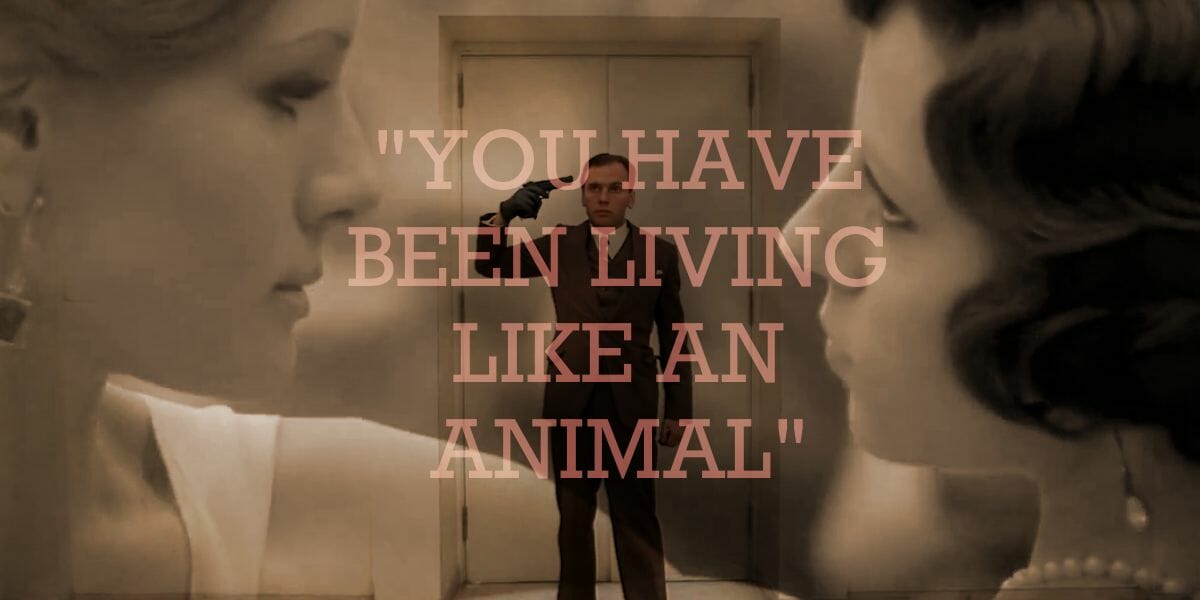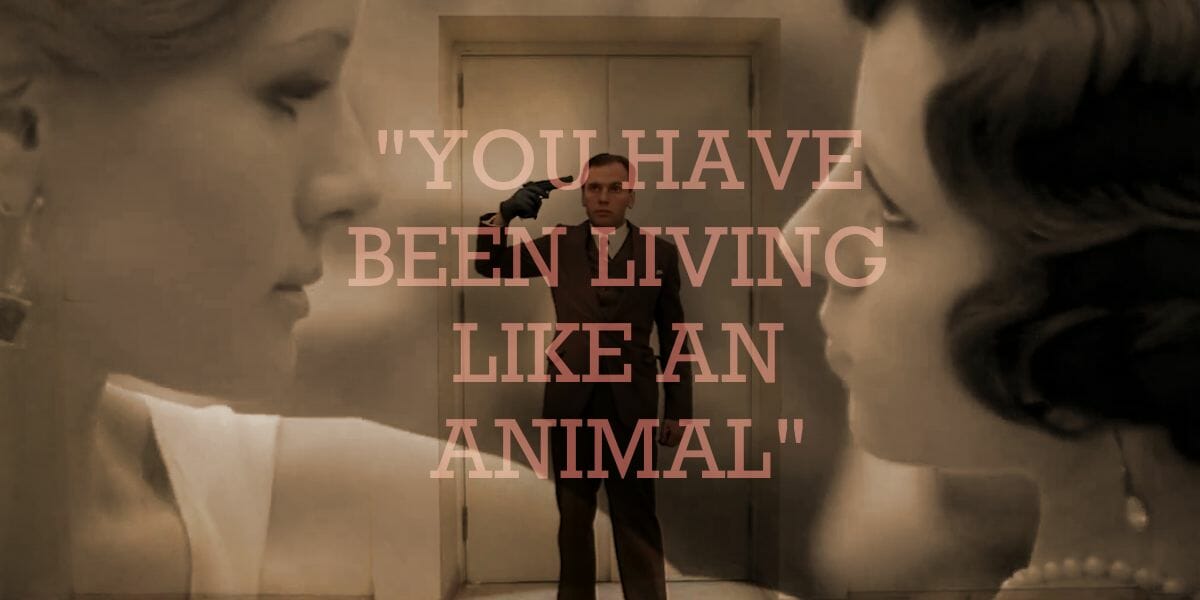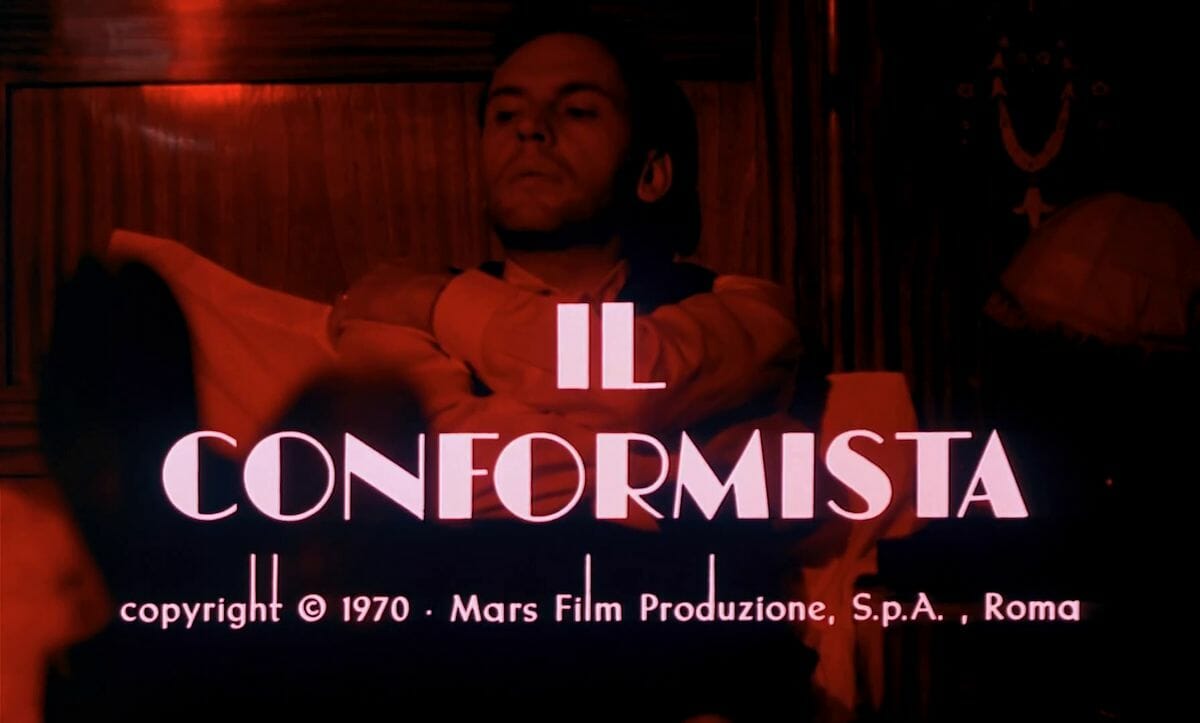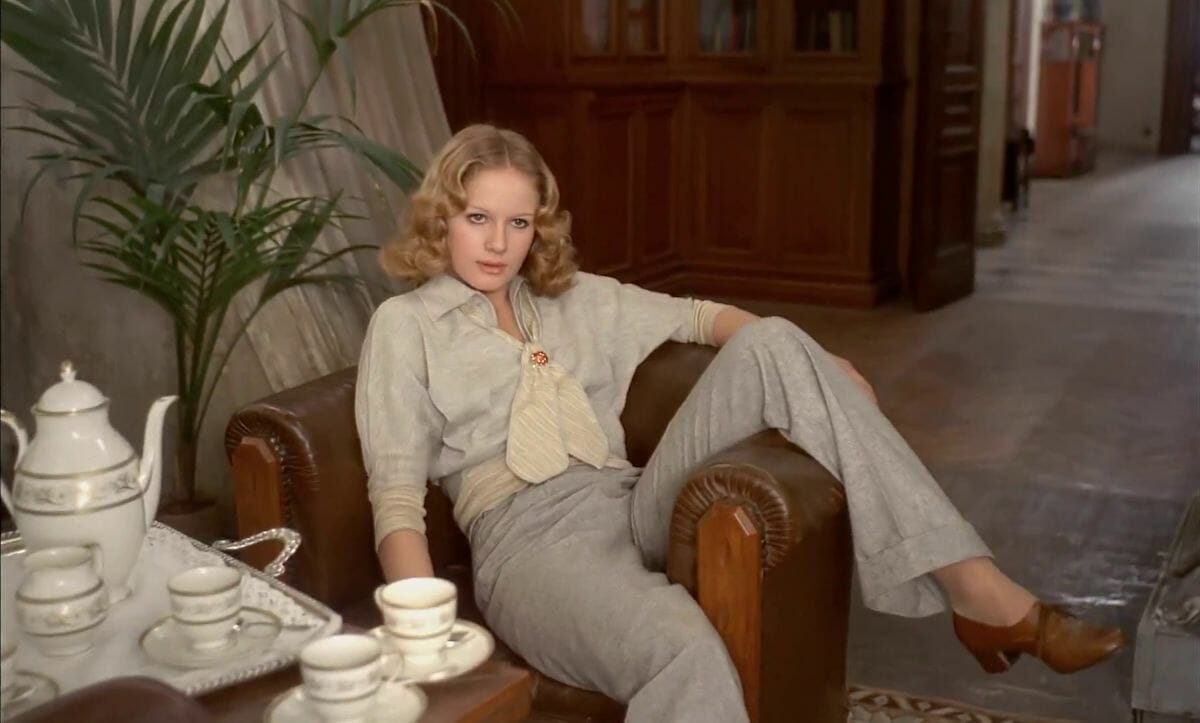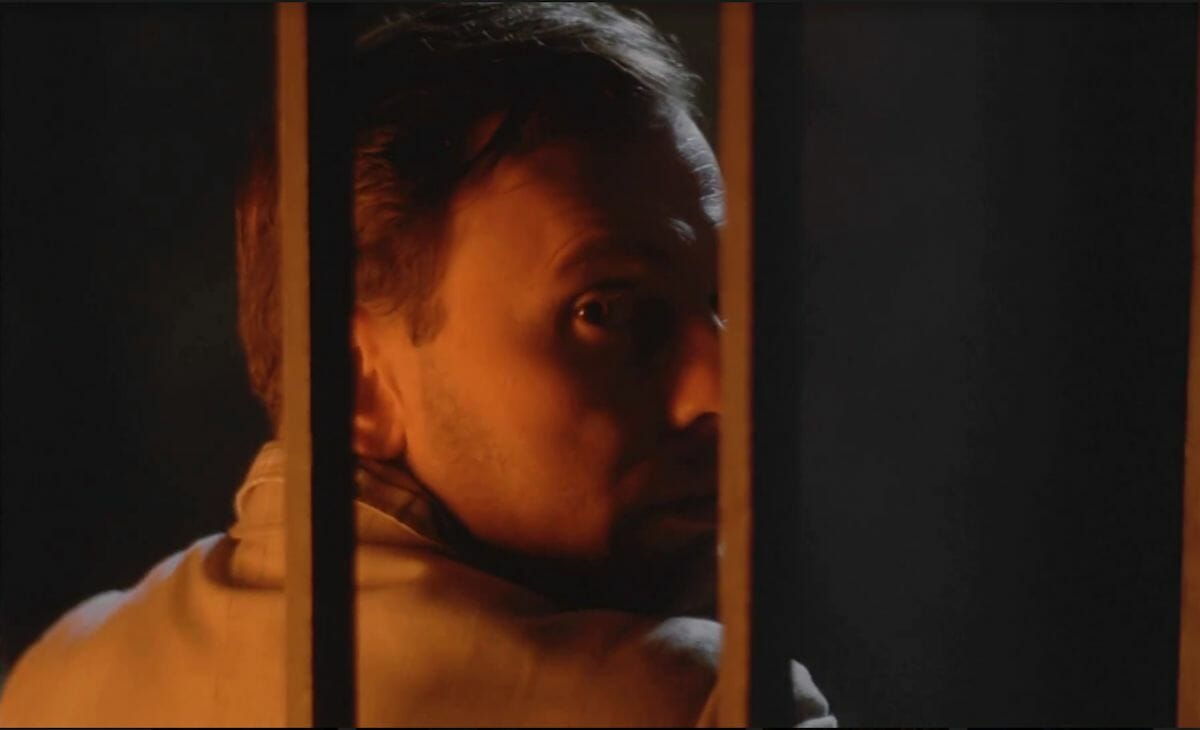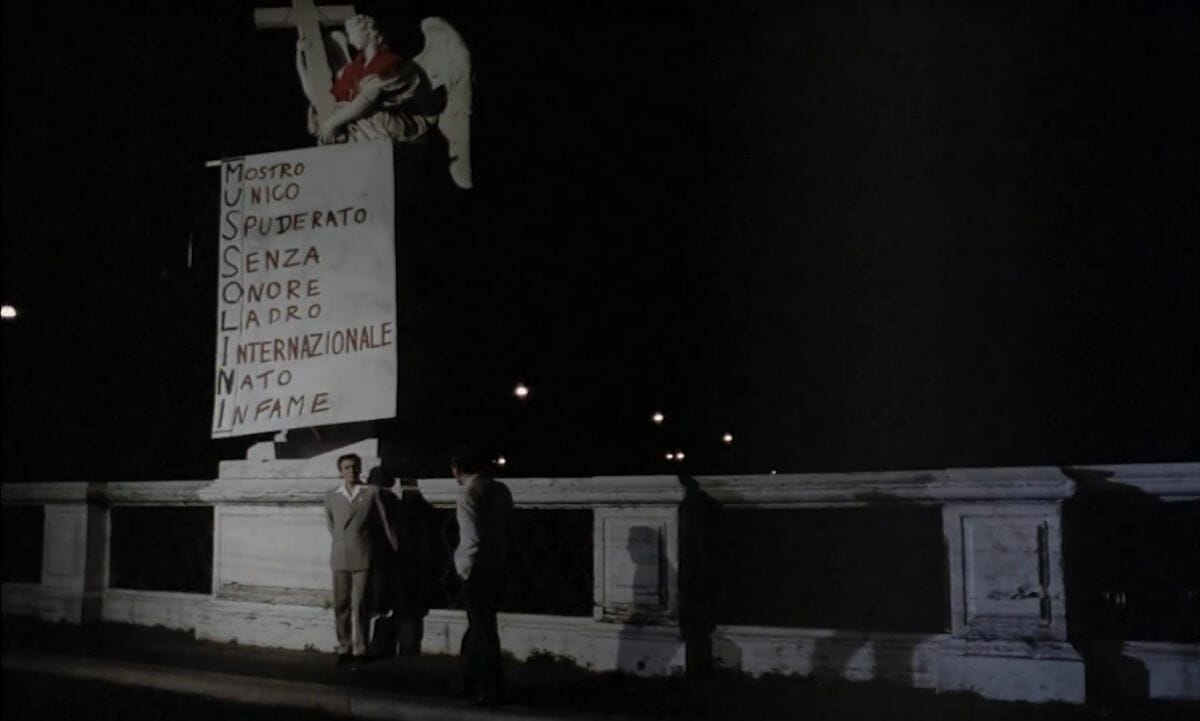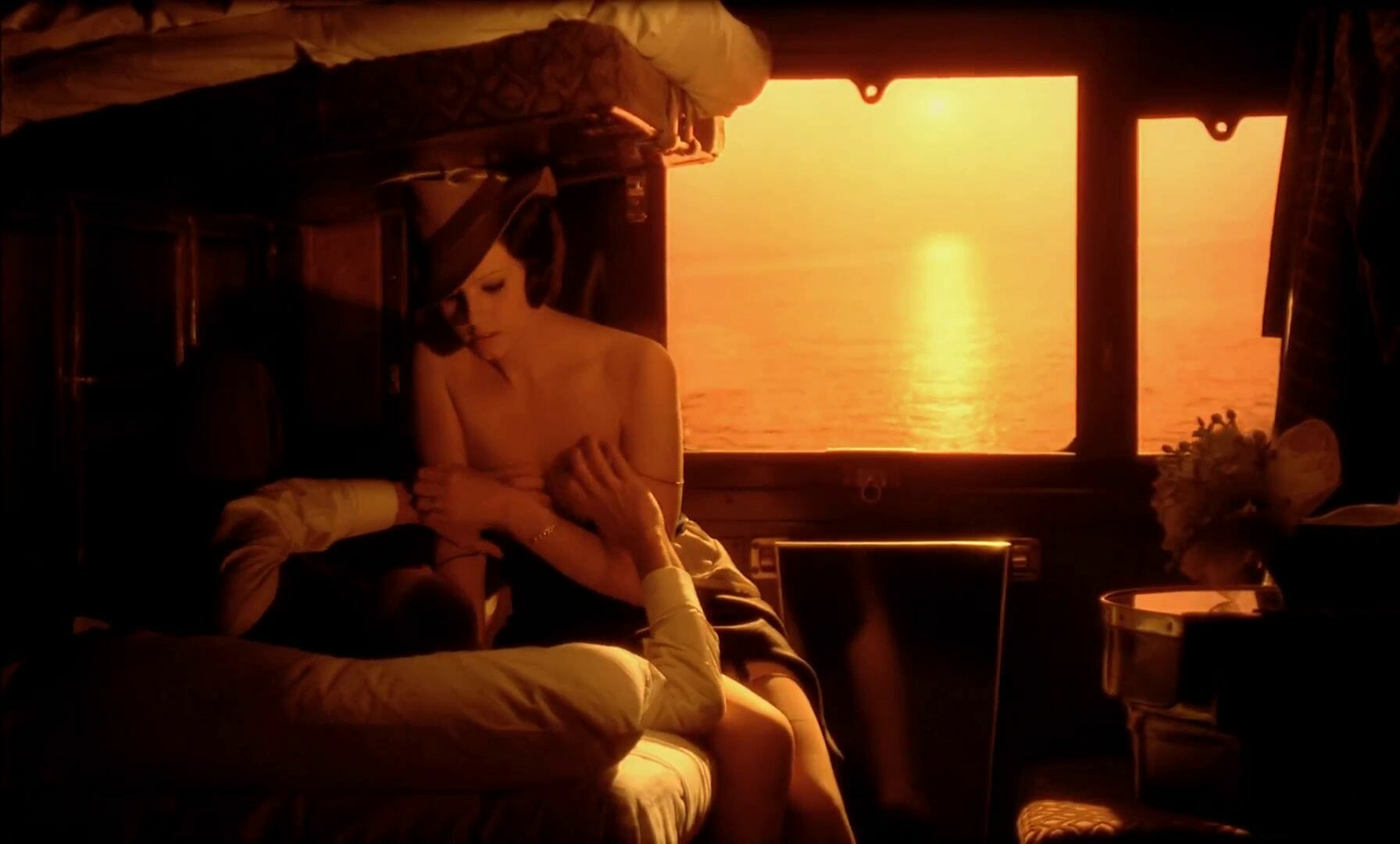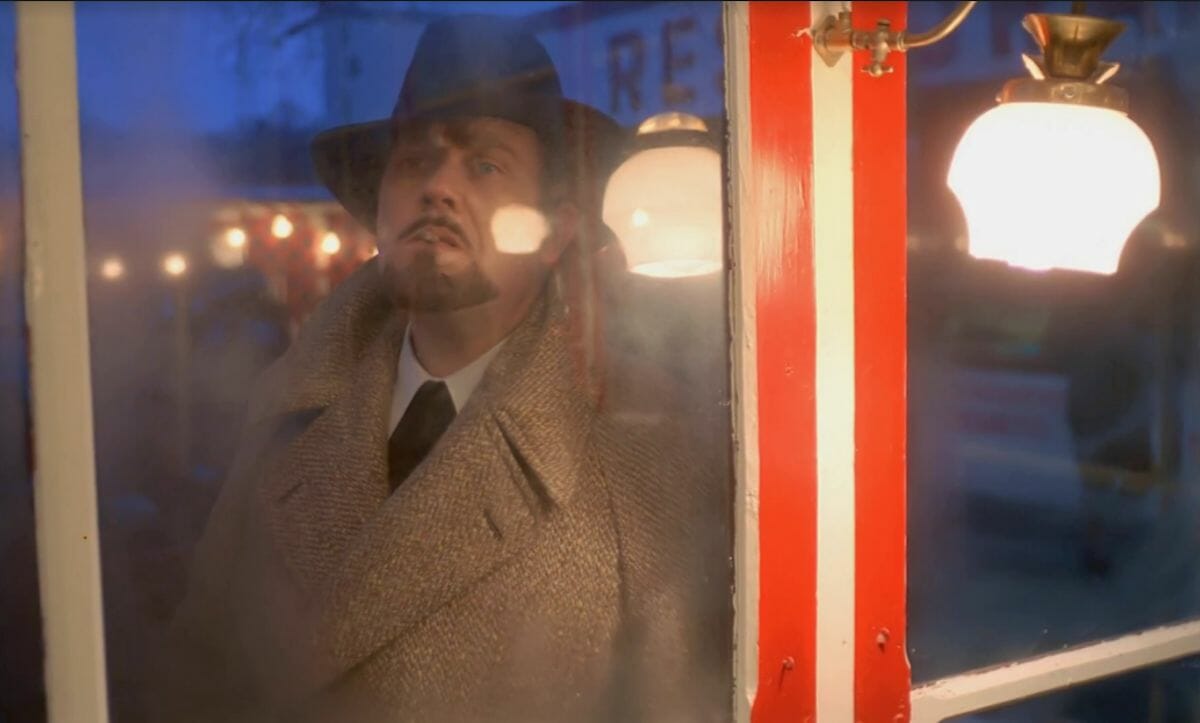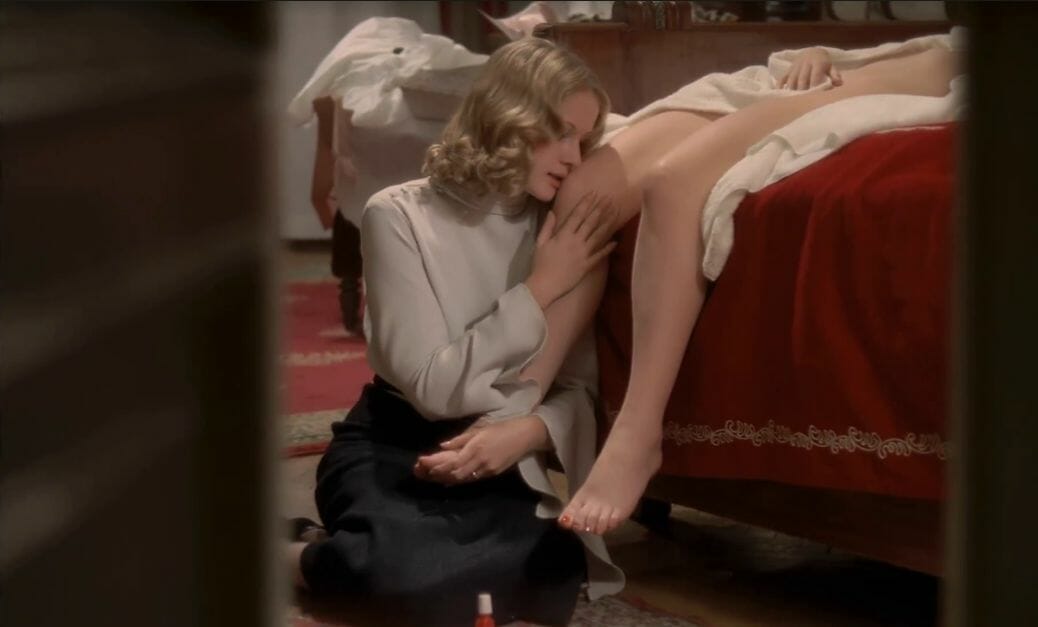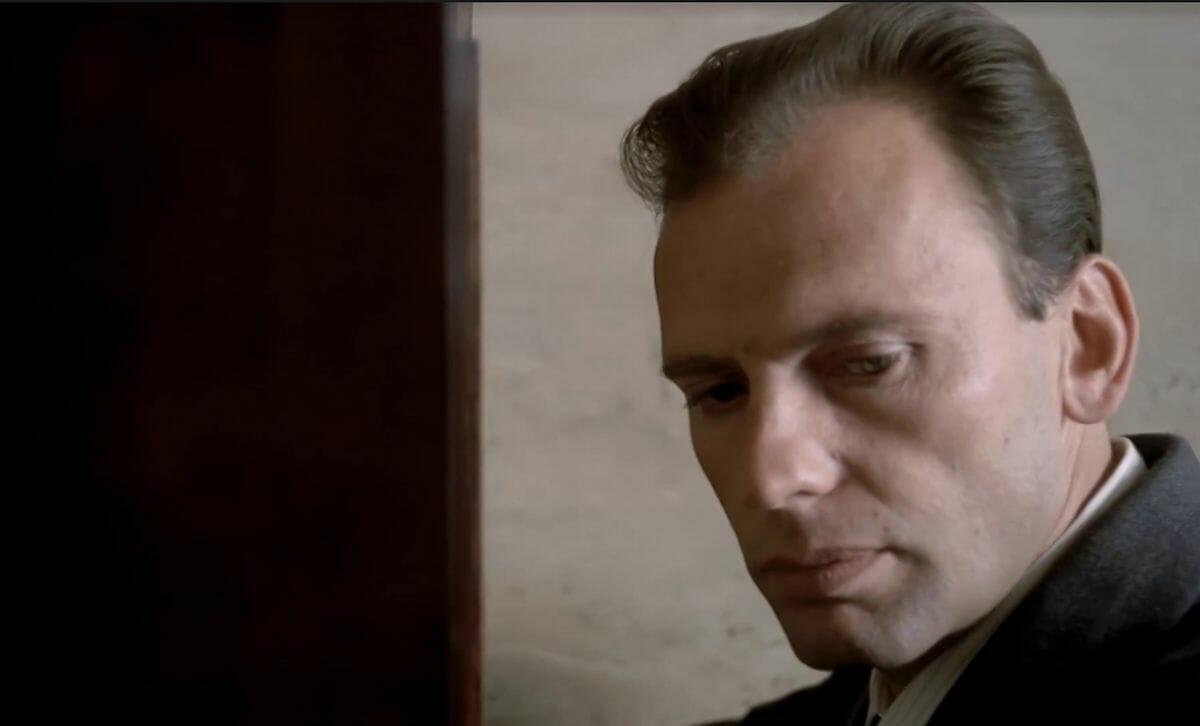In 1943, fascist Prime Minister Benito Mussolini was given a vote of no confidence and replaced. By 1945 — following his second regime in the Salo republic — he and his young wife were dragged out of his bed in the middle of the night and killed, and their bodies were hanged, beaten, and riddled with bullets by a mob in the public square.
Bernardo Bertolucci’s The Conformist largely takes place in the mid 1930s, at the height of the fascist state, and the costuming, buildings, rooms, and lighting of the movie all offer stark 30’s European simplicity. It feels as though there is a perverse need on the part of the filmmakers to make the film gorgeous and enticing. Near the end of The Conformist, however, Benito Mussolini’s expulsion from his position as Italian Prime Minister is announced over the radio; when asked why he is going out, the film’s hero Marcello Clerici— portrayed by Jean-Louis Tritignant — says “I want to see how a dictatorship falls”. In light of our country’s recent shift away from our current head of state in the U.S., this sentence takes on a whole new meaning.
Written and directed by Bertolucci, The Conformist was based on the novel by Alberto Moravia — who also wrote Contempt, which was later adapted into a separate but equally gorgeous love letter to color cinema and the depiction of impotence and uncertainty — though Bertolucci’s concerns are noticeably more internal than the book. The Conformist is so rich, stunning, and symphonically composed that it feels less vicious now than it must have in its initial release.
The film takes place in flashbacks within flashbacks, but flows in such a way that feels as though the audience is actually engaging with Clerici’s memory or subconscious. Bertolucci frames the film around Clerici sitting up all night and being forced to take an hours-long trip to the country home of his assassination target. The audience is able to feel the length of the drive, watching Clerici cold in his overcoat in an unheated car without sleep, and Jean Louis Trintignant’s reticence on the screen makes the lack of his emotional reactions build and build, letting the audience be able to feel just how much is missing by the time they finally catch up to the car.
Marcello Clerici — frequently called Dottore (“Doctor” in English) by his subordinate Manganiello — is a functionary of sorts who asks to join the fascist secret police and investigate his former philosophy professor, Luca Quadri (Enzo Tarascio), a professor turned communist agitator exiled in pre-invasion France. Before crossing over into France, however, he is ordered to kill Quadri, but has second thoughts upon meeting Quadri’s young wife Anna (Dominique Sanda).
This fascist society has used Clerici’s self-disgust as fuel for violence in the name of the state — in this way, The Conformist is a lot like Top Gun. Clerici spends most of the film’s framing device sitting in the backseat of a car, psychologically recreating his role as a child, seeking the exact moment before he felt broken. His early trauma, when revealed, actually doesn’t explain much. He was a bullied child and violently responded to a fey chauffeur’s advances by shooting him — the inciting incident that has driven his desire to be “normal,” a concept which he never defines but is, in many ways, simply a social banality. This trauma is not trauma as fiction usually defines it, instead having Clerici victim-blame himself.
The chauffeur enticed the young Clerici with the offer to show him his gun (Surely no one will ever accuse the director of Last Tango in Paris of being too subtle). The older man — played by Pierre Clementi, most famous for his role as a callow thug in Luis Bunuel’s * Belle De Jour* — begins molesting Clerici, who grabs his gun and shoots him. We learn of this as Tritignant casually relates the incident to a priest, who is more horrified that he’s never confessed the sin rather than by the sin itself. When Clerici says he has not confessed in his 34 years, the fascist, sympathizing priest says “You have been living like an animal”.
Giulia (Stefania Sandrelli) is the only character here with any true appeal beyond an effortless attractiveness: petty, empty headed; as Clerici says: “she’s all bed and kitchen.” It’s fair to say that Clerici wants a petit, bourgeois wife. Aside from her obvious beauty, she is perceptive and forgiving of everything, understanding even the communist and his wife’s romantic advances. However, Clerici doesn’t love his fiance, doesn’t want to kill the communist professor, and seems very distant in his sexual advances toward the woman he supposedly falls for. The strangest quality of the film is the wave of flatness of Anna and Clerici’s relationship — though it doesn’t stay that way long.
The sleight of hand in the way The Conformist is structured is partially due to Gastone Mochin’s portrayal of Special Agent Manganiello — a handsome, comedically adept performer portraying a veteran of multiple campaigns, including a multi-person hit during his time in Africa — which allows room for audiences to sympathize with his character. He is the voice of reason, or at least the guy “who does his fuckin’ job”, to use the Mark Wahlberg parlance.
Manganiello doesn’t want to kill Quadri’s wife, but he will if forced to. There is a violence to the character as he takes up the priest’s argument that violent men are animals, or when he says that the four murders he and his men committed in Africa were justified, and by doing such vile acts they were not beasts, they were men. In this way, Bertolucci seemingly talks through him.
When Clerici refuses to shoot Anna himself, however, Manganiello’s disgust boils over. Manganiello remarks, “If it’s up to me, cowards, homosexuals and Jews, they’re all the same thing. If it were up to me, I’d stand them all against a wall. Better yet, eliminate them when they’re born.” He says this, pulling his cock out of his pants to piss. This aside throws much of the fretting we watch Manganiello do earlier in the movie into harsh relief. This is our ever-so-lovable everyman character, the audience is reminded, and in the end his feelings toward nearly everyone in the film is that of disgust. This is not a good man and perhaps, in the milieu we are being shown, there are no good men.
As vehemently Italian as The Conformist is, it’s also Bertolucci’s love letter to the classic French cinema. There are nouvelle vague touches all over and feels like a playful détournement of Jean Pierre Melville’s Army of Shadows (a truly masterful semi-autobiographical story of the French resistance under the Nazis). Bertolucci, in his perversity, chooses to tell the story of a collaborator, with Clerici and Manganiello dressing like French noir gangsters instead of Italian fascists. When Clerici and Quadri’s wife Anna embrace, it’s shot as if it’s Alphaville; photogenic and luminous. The dubbed version, however, throws out that many scenes are happening in both French and Italian — an alienation is ultimately intentional.
Cinematographer Vittorio Storaro’s immense compositions dwarf these petty and sad people by overwhelming the Clericis and the Quadris with cavernous rooms, and populating them with smiling and lovely crowds — scattering the frame with lunatics, the blind, ballet students, communist intellectuals, hectoring widows; good lighting and bad lighting. As always, Storaro and Bertolucci are carving their story out of light.
A prime example of this can be seen in the first conversation between Clerici and Giulia. Lit by venetian blinds — an effect not of American film noir, but one of a cage made of light — these two people are not free in any sense, instead bound to the most repulsive versions of country, family, gender, love, duty, and decorum. Storaro saw the distinctions between light and dark as the central visual conflict of the film, and immediately went to Caravaggio. Clerici and Anna Quadri are often seen awash in pallid blues, recalling expressionist painting (Liliana Caviani chose the same blues because Hitler despised expressionist painting).
This example of expressionist lighting, in the German silent sense of the term, explores the same profound approach to color that Michelangelo Antonioni and Dario Argento, Bertolucci’s former writing partner, would become synonymous with Italian film. An erotically charged retelling of Giulia’s assault as a teenager by an older family friend is situated as the most luxurious process shot ever filmed; not listening to his fiance’s shameful confession, Clerici takes her clothes off in front of an impossible rear projection and the entire frame washed in a gold sunset, with the color pallet shifting to indigo as the scene shifts to a more erotic theme.
The tragic ending of the film is not situated dramatically at night, but set far up in the pines just after dawn with shafts of sunlight burning off a winter rain and the condensation glowing on the car windows as everything goes to shit. By the time the sun rises, the romance has completely disappeared and we’re watching a woman bleed to death in the cold light of the morning. This sequence was an obvious influence on both The Sopranos and Michael Mann’s Public Enemies, which re-stages the amazing handheld running scene in darkness with digital cameras. This sudden use of handheld cameras — running with faceless killers as they chase Anna down to shoot her in the back — is a banner moment for Storaro.
Bertolucci had good politics but was a terrible human being,and his movies reflect that. He frequently returned to the subjects of (then-) taboo sexuality and stories of fascism and leftism, and while his work is masterful and erotic, it is admittedly sometimes embarrassingly tone deaf; after all, Bertolucci is the same man who cowrote the greatest western of all time, but is more often remembered in death for how he conspired to assault Maria Schneider on the set of Last Tango in Paris. This is reflected in the outdated and often repulsive ideas on display in The Conformist, with themes of deformity, disability and homosexuality seen as deviant.
Similarly framing sexuality and fascistic control are films such as Liliana Caviani’s The Night Porter which looked at fascism as enticing but ultimately doomed erotic space — the story of a young girl ritually groomed by an SS guard in the concentration camps, and their chance meeting decades later. What could be a revenge movie premise instead becomes the holocaust in miniature — they re-enter the relationship and by circumstance starve as their attraction to the power dynamic overtakes their desire to live, making the sexual pull of fascism into an inescapable death drive.
In Dario Argento’s Suspiria (and many of his subsequent films) he makes several direct connections between fascism and black magic. This is done subtly and ingeniously with methods like filming a scene of inexplicable supernatural terror in Munich. Squashing geography goes from the location of the Beer Hall Putsch— also mentioned in The Conformist) —out to a square made famous for one of Hitler’s rallies.
You could describe The Conformist as being in the closet is a metaphor for fascism is a metaphor for being in the closet. It is not only Clerici’s final moment of open want laid bare, but there are so many moments of lesbian desire between Giulia and Anna. Arguably one of the most beautiful moments in the film — so much so that it’s often been the subject of the film’s posters — is the pair of women dancing together. Anna pursues Giulia quietly but forcefully, and Anna laments to Clerici that his wife hates her.
While he’s still in Italy, Clerici sees two women who are the exact duplicate of Anna Quadri (played by Dominique Sanda), showing the interchangeable nature of the women he desires. There is a sad, aching sexuality to The Conformist. It luxuriates in the two women dancing. It presents Anna Quadri as ambiguous sexuality, posting up at the communist intellectual meeting and sitting like a skateboarder. She kisses Giulia’s legs the same way the chauffeur kissed the boy. Overall, the film makes it very clear that what is sexy to our Dottore is not normal at all.
Clerici’s in-script obsession with normality is confronted with how little in his life could be considered normal. There is a cognitive dissonance that defines depictions of fascism — these are the norms of a fundamentally broken system that destroys people from within and poisons them their whole lives. Surely hypocrisy is the target, but Bertolucci is self-indicting in all of his works. What he finds dramatic or titillating is not the same as his politics.
The lingering question of The Conformist is not one about cowardice or weakness— or even fascism, the end — but about the unspoken need buried beneath all the rational and irrational urges in Clerici’s life. He is not burying the secret of a murder or abuse. He is burying himself, and what he actually wants is revealed to him. When the film was released Bertolucci said “In my film there is no destiny. In my film the function of destiny is taken over by something else. The individual’s subconscious.”
As Clerici wanders the burning city with Italo — passing by the statue of Benito’s head being dragged through the streets by motorcycles — he overhears an old dandy seducing a homeless man. The old man is the limo driver who was only scarred by the young boy’s shooting. Marcello Clerici explodes, his voice escalating louder and louder until a crowd of prostitutes shows up to laugh at him. The perfect lighting, perfect framing of Storaro becomes a harried, glaring spotlight as Clerici grabs the limo driver. He elides his own crimes with the chauffeur, accusing him of everything he himself has done, renounces the murders he’s orchestrated, and accuses his friend as being a fascist.
Ultimately, Clarici disavows the entirety of his life to blame his abuser for everything he has done —he didn’t kill them, this man who hurt him did. Jean Louis Tritignant, an excellent actor with a face for restraint another great performance of his is the entirely mute performance in Sergio Corbucci’s The Great Silence allows the audience to feel the emptiness of his character until he collapses in on himself, exploding in this final scene.
The film ends with our Dottore sitting on the street with the attractive homeless man the chauffeur was chatting up. He has destroyed his identity by negating it, rather than ever changing or learning anything. He has invalidated his own life and we as the audience are unsure of who this man ever was. What he wanted is unclear, if he ever wanted anything. Bertolucci doesn’t want to leave us in this man’s annihilation. He’s too cruel for that. Instead, the final moments we watch Clerici turn to the camera and grasp what he may have wanted all along.
What he wants is another man.
